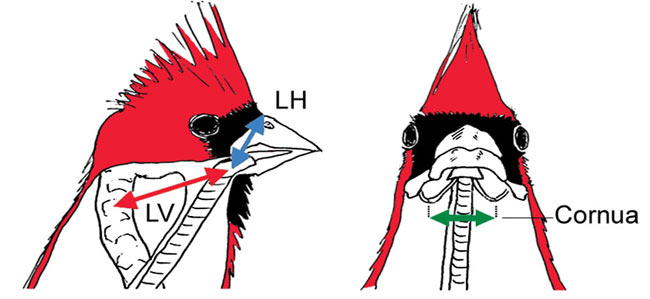How Songbirds Change Tune

New research reveals that songbirds add style to their songs using the same mechanism as humans.
In humans, an "ah" sound originating from the vocal cords can be turned into an "ooh" by moving the lips, tongue, and jaw.
Birds mostly communicate using a variety of up and down sweeping tones and crescendos or decrescendos. The most efficient way to produce these sounds, said study leader Tobias Riede, is to change the shape of the vocal tract, which includes the mouth cavity, pharynx cavity, trachea (or windpipe), and esophagus.
Sound is produced at the bird's syrinx, which works like human vocal cords. As air passes through it, folds of tissue resonate to generate sound. (Birds have a larynx too, and while it plays a role in shaping sound, its primary function is to keep food particles out of the lungs.)
The previous notion was that a bird's upper vocal tract is like a stiff tube, and that the change in sound was a result of changing how wide the beak was open.
But X-ray movies of a singing northern cardinal reveal that the bird rapidly changes its vocal tract shape—from the simple shape of a drinking straw to a voluptuous flower vase—to give the song some flavor.
"The beak plays a minor function, but the upper vocal tract plays a major role in shaping sound," said Riede, a researcher at the National Center for Voice and Speech. "The acoustic role of the vocal tract is to give original sounds from the syrinx a shape, or in singing terms, to give it some color."
Get the world’s most fascinating discoveries delivered straight to your inbox.
The beak's main function during singing, Riede said, appears to be broadcasting the song in a specific direction.
This is the first study to demonstrate that songbirds control their songs using precise motor control similar to humans, and suggests it is useful to use birds to study vocal learning.
"Consider that in birds and humans, the most important similarity is that they have to learn what they vocally produce," Riede told LiveScience. "Here we have another similarity in that humans change their vocal tract to produce different sounds, and birds change their tract in a very similar way, using nerves and muscles that are synonymous in humans."
The study is detailed in the March 27 online edition of the Proceedings of the National Academy of Sciences.


